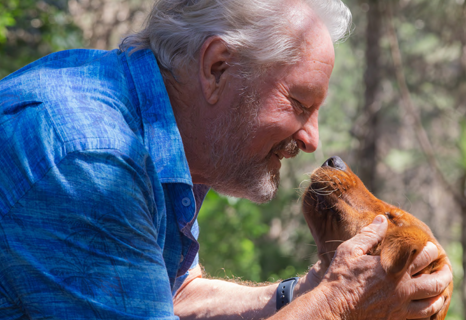A list of what you should do with your puppy to ensure a happy, healthy and well-behaved dog for life!
Getting a puppy is an exciting time, but gorgeous as they are, all puppies do become dogs and it’s important to do the right thing from the beginning to ensure you don’t face any issues later.
The most critical time in a pup’s development is the Formative Period (2-4 months of age), when they are most ripe for learning - 80% of the brain wires up in these months! At this time, you have a chance to shape behaviour rather than trying to change established behaviour – as the saying goes, prevention is better than cure.
Here’s my top list of “must-dos” when you bring a puppy home. If you do all of these things, you will have the best relationship with your dog for life!
(Use the right arrow below to see the full list.)

Mark Vette is a world-renowned Animal Behaviourist, Zoologist and Trainer. He brings together a unique combination of academic studies with 40 years of applied clinical animal behaviour consulting and treatment. Mark is a member of the International Association of Animal Behaviour Consultants. This article was written by Mark and the views expressed are his own.

1. Prepare your house
Set yourself up with everything you need for your puppy’s comfort and training before you bring them home. Here’s my list of essentials:
- Crate (not too oversized) and dog bed to go in it
- Play pen (I find children’s ones are best as they only have vertical bars so your pup can’t climb out easily)
- Puppy pads, newspaper or probably best is astroturf for house training
- Water and food bowls
- Age appropriate food and training treats
- Collar and lead
- Long leads of 5 and 10 metres for training
- Lots of stimulating toys & food puzzles (or make your own budget friendly ones)
- Travel crate or harness for safe car travel
- Clicker and food pouch to ace your training
- White vinegar, when mixed with water it makes a great solution for cleaning up any accidents to neutralise the smell so your pup isn’t attracted back to toilet in the same area again
- An old backpack, pram, trolley or dog stroller for taking pup out to meet people and dogs safely before fully vaccinated (this can just be borrowed, you’ll only need it for a few weeks)
If at all possible, I’d also highly recommend you install a dog door. For renters, you can get a temporary dog door insert from stores like Bunnings that fit into sliding doors.

2. Decide on the house rules
Consistency is going to make your puppy training journey much smoother, and it’s kinder on your puppy too if they know what’s expected of them and aren’t confused by different approaches from different members of the house.
Some things to go through include:
- Making sure everyone understands not to reward undesirable behaviours. If your pup gets pats and attention while they’re jumping up, they will keep jumping up!
- If your pup is allowed on beds and couches
- Who is responsible for feeding, training and walking
- Where puppy is allowed to go in the house
- What the puppy can be fed and when - I would suggest no human food to start with, and no feeding from your plate as this can quickly develop into problematic begging behaviour. Many human foods are also dangerous for puppies, see pawsoff.co.nz to learn which aren’t safe
- What key commands you will teach the pup and use, it’s best if everyone uses the same
- Your training approach, I recommend focusing on positive reinforcement using a clicker
- Boundaries for your pup e.g. don’t disturb the puppy when they are eating or sleeping
- Handling rules, especially for children e.g. children can’t pick the puppy up, no tight hugs, no pulling legs or tails etc
- Keeping items you don’t want chewed out of your pup’s reach while they're still learning what they can and can’t chew

3. Keep the first few days calm
It’s a huge transition for your pup to leave their mother’s den and littermates to move into your home. This big period of adjustment coincides with a fear imprint period, meaning your pup will be more sensitive to new things and more prone to frights.
Your home is a whole new environment full of unknown smells, noises, objects and experiences and your pup is experiencing so many firsts. Pups can easily develop site aversion so you want to ensure your pup’s new home feels like a place of safety and comfort.
The best thing you can do is create a calm atmosphere for those first few days. Watch out for loud noises and ensure children are calm around the new pup. Include smells from the pup’s previous den/breeder if possible. Avoid anything that may give your pup a fright, and don’t expect too much from your pup too soon. The main thing for the first few days is to focus on getting a good routine set up and bonding with your beautiful new family member.

4. Bond with your pup
One of the most important things you can do with your pup is to build a strong bond. When you have a strong bond, your pup looks to you for direction and stays close to you. This makes every aspect of training so much easier as your pup WANTS to pay attention to you. Many behavioural issues stem from poorly established bonds between the pup and owner, so it’s worth putting in the effort to establish and maintain a loving attachment relationship. Some easy ways to do this include: lots of cuddles and play together; providing guidance and boundaries; controlling access to your pup’s resources; maintaining a calm, confident disposition for your pup; and doing positive reinforcement training. Basically, take the time to connect with and love your pup, it’s not all about obedience!

5. Socialise, socialise, socialise
You MUST socialise your puppy with lots of different people of all ages, races and gender (including young children) as well as other dogs, and other animal species such as cats, chickens and livestock. If you don’t, you risk raising a dog that shows fear-based issues, aggression or unacceptable prey drive. Even though this time conflicts with your puppy’s vaccination period, you still need to find ways to socialise in a safe manner - some good options are puppy schools, taking your pup out in a front pack or dog stroller, meeting vaccinated dogs at their home or yours, walking below the high tide line at the beach or doing outings to pet-friendly stores and cafés.

6. Exposure to everything
Your puppy is developing its important coping mechanisms and ability to deal with novelty as an adult dog, so it needs lots of different experiences to avoid becoming fearful of these things later.
Here’s a list of some of the things you should expose your new puppy to, after you’ve given them a few calm days to settle in.
- Busy roads and motorbikes
- Fireworks, thunder and heavy rain (if none is forecast, play recordings of them)
- Household sounds like vacuums, pots banging, loud music, lawn mowers
- Car travel
- Vet visits
- Skateboards, scooters, prams
- Sports games
- Children squealing and behaving in their normal unexpected ways
- Big movements like umbrellas opening unexpectedly
- Basically, anything you can think of!
Between 2 – 4 months of age, your puppy’s “fight or flight” fear response hasn’t yet fully developed, so they are not afraid of anything, making it a perfect time to give them lots of experiences before they can develop a fearful response to them. Use clicker and treats to keep your pup calm and accepting as they encounter new things, the idea is to make it positive as your pup’s first experience with something sets the tone for how they will react to that thing going forward.
You are NOT trying to frighten your pup, some pups will be more sensitive so don’t push them too far too fast.

7. Teach training foundations
Teach the basic commands – sit, down, come, heel, no, leave it, wait, stay, quiet and no. Cement these commands in nice and early, so that they’re wired in for life!

8. Set boundaries and reward only good behaviours
Don’t allow your puppy to do anything you wouldn’t let an adult dog do, such as jumping on the couch or sleeping on the bed (if you don’t want them to), jumping on you or play biting. Also recognise when you might be accidentally rewarding undesirable behaviour - if you pet or pick up your puppy when they are whining, you’re rewarding the whining and building that habit for life. Be consistent, it will be hard to change these behaviours once they’re established.

9. Leave them alone
Don’t spend every minute with your puppy or they may develop separation anxiety, which is highly stressful and difficult for a dog to deal with – a bit of tough love is required! You need to teach them how to gradually separate from you for longer and longer periods – starting with short stints of time away and slowly increasing this. A crate makes separation work much easier, as it allows you to safely contain your pup while preventing them from toileting inside or becoming destructive while you’re gone. Give them a nice chew treat to help them settle when you leave.
Good luck with your new puppy, it can be both a wonderful and overwhelming time! But with a bit of preparation and understanding, you’ll come out the other side with a best friend for life. Enjoy!
Always consult your vet on the best way to look after your pet. And to avoid unexpected costs, make sure your pet is insured.
Have a look at our pet insurance plans to choose the right insurance plan for your pet.

